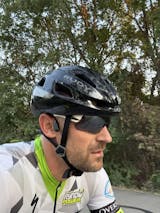Say “Yes!” to Winter Triathlon Training

Triathlon training in winter is where your top performances of the spring and summer — and fall, if you’re gunning for an Ironman — start. That’s because the key to better year-over-year performance comes from consistent training, not necessarily a complex and high-intensity program squeezed into a few months before your event. If you’re coming off a solid year of training and events, winter is when you strengthen that fitness foundation you earned and build a stronger, faster you for the upcoming year. Here’s how you do it.
Swim
Unless you live in a warm and sunny climate where you have year-round access to outdoor pools, winter triathlon training means diving into an indoor facility to get your strokes in. And make no mistake, you must get your strokes in. Aim for at least one swim session a week, and focus on drills and technique rather than speed and distance work. The goal here is to maintain your swimming stroke and make yourself more efficient in the water.
Safety First: Cold-water swimming in the winter can be done with heavy-duty wetsuits, booties, and gloves, but not all accessible lakes or beaches will allow swimming if the water temperature drops below a certain temperature threshold. Better to be safe and put that money toward the splurge below.
Splurge: If you’re taking a holiday or spring break vacation to someplace with warmer weather, look for an outdoor pool with drop-in hours where you can put together three or four days of distance workouts — and enjoy swimming outside for the first time all year.
Bike
Leave your tri-bike on the indoor trainer. Instead, outfit your road bike or mountain bike with fenders, wider, puncture-proof tires, and waterproof lube on your bike chain. Then hit the road. The key here is to log steady miles and maintain your pedal stroke, balance, and coordination — and get some fresh air in the process. Try to ride once a week if possible.
Dress for the weather, starting with a thermal baselayer, then a long-sleeved jersey, and covered by a waterproof rain jacket. For your legs, pull on some full-length thermal cycling tights or knickers and thicker wool cycling socks. Invest in a good pair of winter cycling gloves and booties that fit over your cycling cleats. If you start overheating, you can always stuff your rain jacket and gloves in your jersey pocket.
Safety First: Choose bright, high-visibility gear for winter riding, so you stand out on the road. Your rain jacket and jersey should be a bright color, and even your helmet can help you be seen. See the Rudy Project Venger helmet as an example.
Don’t forget your sunglasses. At the very least, wrap-around glasses protect your eyes from rain, snow, or spray and allow you to see the road or path ahead clearly. For the ultimate in winter training eyewear, try the Rudy Project Agent Q, which combines the best features of high-performance triathlon sunglasses with the protective qualities of winter goggles.
Splurge: Got snow? Look into a fat-tire mountain bike. Its huge tires will let you ride on snow, through powder, over ice, mud, and slop. Best of all, it’ll get you riding outside no matter the conditions.
Run
Of the three triathlon disciplines, running is the easiest to continue through the winter. It’s easy enough to warm up quickly, so there’s no need to wear heavy clothes. And it beats spending hours on a treadmill. To run outside, dress in layers but don’t overdress — you want to feel uncomfortably chilly when you start your run. Wear wool socks, a hat, and gloves. When you start to warm up, take off your gloves first. Still warm? Remove your hat. Still too hot? Okay, now it’s time to lose the jacket.
Safety First: Running in the winter usually means logging miles in the dark. So wear high-visibility, reflective clothing and maybe even a headlamp. And don’t forget, even in low-light settings, glasses still matter. Glasses with a light-yellow lens tint will cut glare off snow, ice, and rain, allowing you to better see contrasts and details (or dangers!) on the trail or road ahead. In the dark, the lenses will dim the glare from on-coming headlights, improving your field of vision and reducing eye strain. Rudy Project’s DeltaBeat sunglasses with photochromic lenses offer the best of all worlds: lenses that are clear in low-light conditions and transition to reflection-killer shades for blue-bird snow days.
Splurge: If running on icy roads, snow-packed trails, or in the cold winter rain, lace up a pair of waterproof, breathable trail-running shoes for their improved traction and ability to keep your feet dry and warm.












